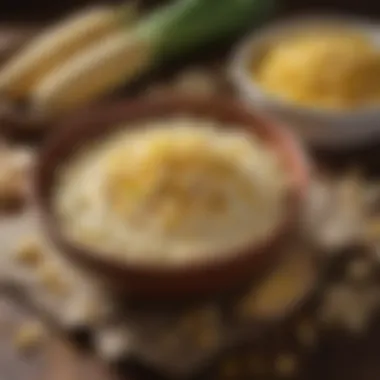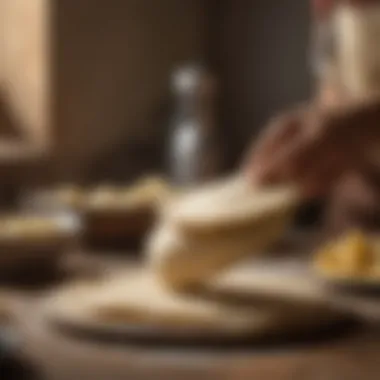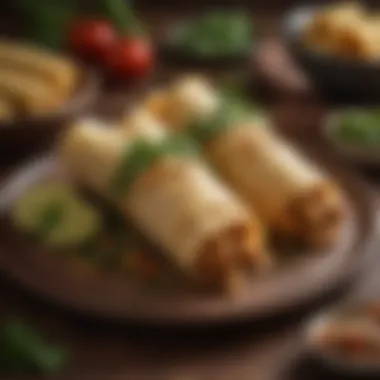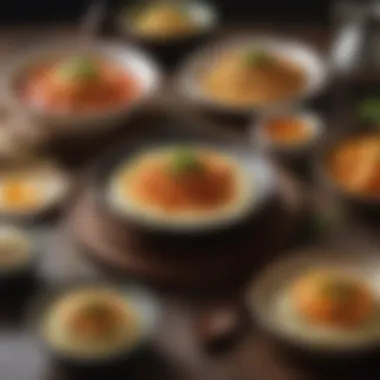Exploring Masa Harina: Culinary Applications and Insights


Intro
Masa harina holds a pivotal place in the culinary traditions of various cultures, prominently in Latin American cuisines. Ground from specially processed corn, it serves as the foundation for numerous beloved dishes. This introduction will explore the versatility of masa harina, its nutritional advantages, and how it can enrich both traditional and modern recipes. By understanding its origins and applications, food enthusiasts can fully appreciate its role in global gastronomy.
Recipe Overview
Masa harina is primarily used to prepare tortillas, tamales, and empanadas. Each dish showcases its unique texture and flavor, providing a taste of cultural heritage. Tortillas, for example, are a staple in Mexican cuisine, often enjoyed with various fillings or as a side to many meals. Tamales, on the other hand, are a traditional dish with roots in ancient Mesoamerican societies, where they were often used in ceremonial events and celebrations.
Understanding the origins of masa harina enhances the appreciation of these dishes. The process of making masa harina involves nixtamalization, where corn is soaked in an alkaline solution to enhance its nutritional value and flavor. This ancient technique not only transforms the corn but also connects the present to the culinary practices of Indigenous peoples.
Ingredients List
- Masa harina (preferably from white or yellow corn)
- Water (room temperature)
- Salt (to taste)
Special Ingredient Notes
- When selecting masa harina, it is essential to choose a brand known for quality. Popular brands include Maseca and Bob's Red Mill.
- If masa harina is unavailable, you can use cornmeal, but the texture and taste will differ significantly.
- Fresh ingredients can elevate the flavor—consider adding spices or fresh herbs for a unique twist.
Remember, masa harina is not only an ingredient; it's a gateway to discovering rich culinary traditions. Its versatility allows for various adaptations, making it essential in modern cuisine. As we continue to explore this ingredient, readers will find that its applications are nearly limitless.
Understanding Masa Harina
Masa harina is a fundamental ingredient in Latin American cuisine, yet its allure goes beyond just taste. Understanding masa harina involves delving into its multifaceted nature, which spans nutritional, historical, and cultural dimensions. This section presents essential insights into what masa harina is, where it came from, and why it holds significant importance in culinary practices.
Definition and Description
Masa harina is a type of flour made from nixtamalized corn, known as masa. The nixtamalization process involves soaking and cooking corn in an alkaline solution, usually limewater or ash, which enhances the nutritional value of the corn. This process not only makes the corn more digestible but also transforms its flavor. The result is masa harina, which is often used to create tortillas, tamales, and other staple foods throughout Latin America.
Masa harina is distinct from regular cornmeal as it has a unique texture and flavor, attributed to the nixtamalization. It can be found in various colors depending on the type of corn used: white, yellow, and blue, with each variety bringing its own characteristics to the dishes.
Historical Context
The history of masa harina is deeply rooted in the agrarian societies of Mesoamerica, where corn has been a staple crop for thousands of years. Archaeological evidence suggests the domestication of maize in Mexico around 9000 years ago. The practice of nixtamalization likely began shortly after the cultivation of maize, as early cultures discovered the benefits of treating corn with alkaline substances.
Over the centuries, the techniques of preparing masa have been passed down through generations, becoming integral to various cultural identities. The culinary applications have expanded beyond traditional boundaries, particularly as migration and globalization have introduced masa harina into a broader array of culinary scenarios.
Cultural Significance
Masa harina is more than just an ingredient; it embodies cultural heritage, tradition, and identity. In many Latin American countries, dishes made with masa harina are part of daily life and community gatherings. For instance, tortillas are not merely food items but also a source of pride and a representation of cultural history. In regions such as Mexico and Central America, the act of making tortillas can be a communal event, fostering social bonds.
Moreover, masa harina serves as a connection to cultural roots for many people living outside their homelands. Through dishes like tamales or enchiladas, individuals maintain a link to their ancestry and traditions, reflecting the resilience and adaptability of culinary practices.
"Masa harina is pivotal in understanding the culinary landscape of Latin America, representing both sustenance and cultural expression."
By grasping the importance of masa harina through its definition, historical journey, and cultural relevance, one can appreciate its foundational role in many cuisines. This understanding sets the stage for exploring its nutritional aspects and diverse culinary uses.
Nutritional Aspects of Masa Harina


Masa harina is not only a versatile ingredient in culinary applications but also holds significant nutritional value. Understanding the nutritional profile is essential for food enthusiasts, chefs, and health-conscious individuals alike. It allows for informed decisions about incorporating masa harina into various diets. This section examines the specific nutritional elements, health benefits, and dietary considerations associated with this unique ingredient.
Nutritional Profile
Masa harina, which is made primarily from corn through a process called nixtamalization, offers a unique set of nutrients. It typically contains carbohydrates, protein, and fat, making it a good source of energy.
Some key components of its nutritional profile include:
- Carbohydrates: Masa harina is high in carbohydrates, providing a robust energy source, essential for active lifestyles.
- Protein: It offers moderate protein content, important for muscle repair and growth.
- Dietary Fiber: The fiber present aids in digestion, promoting a healthy gut.
- Vitamins and Minerals: Masa harina contains essential vitamins like B vitamins and minerals such as magnesium and phosphorus.
"Masa harina provides a balance of macronutrients and is enriched with essential vitamins and minerals, which is why it plays a key role in diets, especially in Latin American countries."
Health Benefits
Including masa harina in your diet can lead to several health advantages, provided it is consumed as part of a balanced diet. Here are some notable health benefits:
- Energy Boost: Its carbohydrate-rich nature makes it an excellent source of energy. This is especially useful for athletes or anyone engaging in physical activities.
- Digestive Health: The fiber content in masa harina helps in maintaining digestive health by preventing constipation and promoting regular bowel movements.
- Sustained Energy Levels: When combined with protein sources, it provides sustained energy release, making it a suitable choice for meals that keep you full longer.
- Gluten-Free Option: Masa harina is naturally gluten-free, making it an ideal ingredient for those with gluten intolerance or celiac disease.
Dietary Considerations
While masa harina presents numerous benefits, it's important to consider dietary needs and preferences. Some potential considerations include:
- Caloric Content: Due to its high carbohydrate content, individuals monitoring caloric intake should consume masa harina in moderation.
- Balanced Nutrition: Using masa harina as part of a balanced meal is essential. Combine it with proteins, fats, and vegetables to enhance nutritional value.
- Culinary Adaptability: Since masa harina can substitute for regular flour in many recipes, it provides an opportunity to explore diverse culinary techniques while adhering to specific dietary requirements.
Types of Masa Harina
Understanding the types of masa harina is crucial for appreciating its various culinary applications. Each type brings unique flavors, textures, and colors to the table, making it suitable for different dishes and preferences. Moreover, knowing the differences among white, yellow, and blue masa harina allows cooks to make informed choices when preparing recipes.
White Masa Harina
White masa harina is the most commonly used version in various traditional dishes. It is made from white corn that has been treated with lime in a process called nixtamalization. This process enhances the flavor and increases the nutritional value. The texture of white masa is very fine and smooth, allowing for a pliable dough that is easy to work with.
Key Characteristics:
- Flavor: Mild and slightly sweet.
- Uses: Ideal for making tortillas, tamales, and various snacks.
- Nutritional Benefits: Contains essential vitamins such as niacin and is a good source of fiber.
Because of its versatility, white masa harina is a staple in many households. It effortlessly adapts to different culinary styles, making it a preferred choice for both traditional and modern recipes.
Yellow Masa Harina
Yellow masa harina, as the name suggests, is made from yellow corn. This type is less common compared to the white variant but offers distinct advantages. Yellow corn has a slightly more robust flavor, giving dishes a bolder taste. Additionally, yellow masa harina is often richer in beta-carotene, contributing to its vibrant color.
Key Characteristics:
- Flavor: Rich and earthy.
- Uses: Suited for making tamales, tortillas, and even cornbread.
- Nutritional Benefits: Contains higher levels of carotenoids, promoting eye health.
While it may not be as widely used, yellow masa harina shines in recipes that benefit from its strong flavor. Those looking to experiment will find that it adds character to traditional dishes.
Blue Masa Harina


Blue masa harina is made using blue corn, which is less common and often regarded as a delicacy. The unique hue and distinct flavor profile have made it a favorite among culinary enthusiasts. The use of blue corn dates back centuries and is prominent in various indigenous cultures in the Americas.
Key Characteristics:
- Flavor: Nutty and slightly sweet.
- Uses: Excellent for tortillas and other traditional recipes seeking a unique twist.
- Nutritional Benefits: High in antioxidants, particularly anthocyanins, which can reduce inflammation.
Blue masa harina not only offers visual appeal with its striking color but also elevates the nutritional value of dishes. Its rarity makes it a prized ingredient in contemporary cooking.
Each type of masa harina serves a unique purpose in diverse cuisines, enriching both traditional and innovative recipes.
Cooking with Masa Harina
Cooking with masa harina is essential to understand its versatility and depth in culinary applications. This ingredient opens a pathway to a variety of traditional dishes. It is a starting point for recipes that can easily adapt to modern tastes. Moreover, cooking with masa harina supports cultural storytelling, as many of these dishes have deep roots in history. This section will outline different preparation techniques, popular recipes, and innovative uses of masa harina, further emphasizing the benefits of this ingredient.
Preparation Techniques
The preparation of masa harina is straightforward, contributing to its appeal in various kitchens. The most common technique involves mixing masa harina with water to form a dough. The water-to-masa harina ratio is vital, as it can change the final texture of the dish. Here are some fundamental steps to consider:
- Mixing: Combine masa harina with warm water in a bowl. A common ratio is about 2 cups of masa harina to 1 cup of water. Adjust based on desired consistency.
- Kneading: Knead the dough until it becomes smooth. This helps develop the texture necessary for making tortillas or tamales.
- Resting: Allow the dough to rest for about 30 minutes. This step enhances flavors and improves elasticity.
- Shaping: Shape the dough into desired forms, whether it is small balls for tortillas or larger pieces for tamales.
These techniques ensure not only a successful outcome but also a deeper appreciation for the ingredient itself.
Popular Recipes
Tortillas
Tortillas are perhaps the most iconic use of masa harina. This dish is fundamental in Latin American cuisine, serving as a base for numerous meals. Tortillas carry a key characteristic: their ability to complement a variety of fillings, from beans to meats. They are beneficial as they can be gluten-free and offer a flavorful alternative to bread. The unique feature of tortillas is their flexibility; they can be served as wraps, with sauces, or even as chips. The advantage here is that they are simple to prepare and can be made fresh, enhancing any meal's taste.
Tamales
Tamales represent another significant culinary application of masa harina. They consist of masa dough filled with various ingredients, wrapped in corn husks, and steamed. This dish showcases the key characteristic of tamales: their hearty fillings. They can include meats, cheeses, or vegetables that add depth to the overall flavor. Their unique feature is the combination of textures—soft masa with a savory filling, steamed to perfection. While they require more preparation time than tortillas, the result is a dish that embodies tradition and comfort food in many households.
Sopes
Sopes provide another exciting approach to masa harina. Typically, these are thick, round bases topped with various ingredients like beans, cheese, or salsa. The key characteristic of sopes is their slightly raised edge that holds toppings well. Sopes are beneficial because they offer a customizable experience; each person can create their unique version. Their unique feature is the crispy texture achieved from frying the masa base, offering a satisfying crunch. However, they can be a bit more time-consuming due to the frying process, requiring attention to detail.
Arepas
Arepas showcase the adaptability of masa harina beyond traditional Latin American dishes. Originating from Venezuela and Colombia, these cornmeal cakes can be grilled, baked, or fried. The key characteristic of arepas is their versatility; they can be filled or topped with an array of ingredients, from cheese to avocado. They are beneficial options for both savory and sweet dishes. The unique feature of arepas is their ability to be crispy on the outside while remaining soft inside. Despite the simplicity of their preparation, they offer a diverse eating experience that appeals to many.
Innovative Uses in Modern Cuisine
Recent culinary trends have seen masa harina incorporated into various modern dishes beyond traditional boundaries. Chefs explore this ingredient in unexpected ways: by using it in batters for fried vegetables, enhancing pizza dough for a gluten-free option, or even as a thickener for soups and stews. The creativity surrounding masa harina enriches both the ingredient itself and the dishes it enhances, demonstrating that this staple can transition smoothly into contemporary cooking.
Exploring innovative techniques with masa harina not only diversifies flavors but also pays homage to the ingredient's rich heritage.
Selecting and Storing Masa Harina
Selecting and storing masa harina is crucial for both the quality and flavor of the dishes you create. The right masa harina can elevate your culinary experiences, while improper storage can lead to spoilage and diminished taste. Understanding how to choose and maintain your masa harina ensures that you make the most of this versatile ingredient. Below, we dive into the essentials of choosing high-quality masa harina and the best practices for storing it.


Choosing Quality Masa Harina
When it comes to masa harina, quality can significantly affect the outcome of your recipes. Here are some key considerations to keep in mind:
- Look for Nixtamalized Masa Harina: This process involves soaking corn in lime water, enhancing flavor and nutrient availability. Brands like Maseca and Bob's Red Mill offer varying forms of nixtamalized masa.
- Check the Ingredients: Simple is often better. The best masa harina will have corn as the primary ingredient, with no unnecessary additives or preservatives.
- Product Origin: Consider where the product is sourced. Mexican brands tend to maintain closer ties to traditional methods, often resulting in improved flavor and quality.
- Texture and Appearance: Good masa harina should be finely ground, with a consistent texture. It should have a somewhat yellow or white sheen depending on the type, indicating freshness.
Storage Recommendations
Proper storage is key to maintaining the freshness of masa harina. Follow these tips to ensure its longevity:
- Keep It Cool and Dry: Store masa harina in a cool, dry place, away from direct sunlight. Moisture can lead to clumping or mold growth.
- Airtight Containers: After opening, transfer masa harina to a sealed container to protect it from air exposure. Glass jars or plastic containers with tight lids work well.
- Refrigeration: For extended shelf life, keep masa harina in the refrigerator. This slows down the oxidation process and preserves its quality. Just be sure to allow it to return to room temperature before using it for cooking.
- Watch for Expiration Dates: Like any food product, masa harina does have a shelf life. Check the packaging for expiration dates and use before this time to ensure optimal quality.
Proper selection and storage of masa harina can significantly enhance your cooking experience, allowing you to create authentic and flavorful dishes with ease.
Masa Harina in Global Cuisine
Masa harina plays a crucial role in various culinary traditions across the globe, especially in Latin American regions. It serves not only as an essential ingredient but also as a bridge between different cultures. This section examines its significance, highlighting specific elements such as regional variations and the rise of fusion dishes that employ masa harina.
Regional Variations
The various uses of masa harina can be seen in the distinct culinary practices of different regions. In Mexico, masa harina is foundational. Food items like tortillas, tamales, and sopes heavily rely on this ingredient. Each region has its own methods of preparation and cooking techniques, giving rise to diverse textures and flavors.
In Central America, countries such as Guatemala utilize masa harina to create pupusas, thick corn tortillas filled with various ingredients. Meanwhile, in South America, especially in Colombia and Venezuela, arepas are central in everyday meals. These round, flat breads are versatile; they can be grilled, baked, or fried and are often filled with cheese, meats, or vegetables.
The preparation methods and culinary traditions surrounding masa harina significantly reflect local customs and histories. Such variations contribute to a rich tapestry of dishes that each tell a story of its origins.
Fusion Dishes
As globalization continues to shape culinary landscapes, mas harina has made its way into innovative fusion dishes. Chefs across the world are experimenting with this ingredient, merging it with non-traditional flavors and cooking styles. For example, masa harina can be found in non-Latin dishes like gourmet pizzas where the crust is crafted with masa flour, providing a unique taste and texture.
Another popular example is the use of masa harina in gluten-free baking. As interest in gluten-free diets increases, masa harina serves as a suitable alternative in recipes such as muffins or cookies, offering a distinct flavor profile while catering to dietary needs. The distinct texture of masa harina makes it an interesting choice for both savory and sweet dishes.
These fusion trends not only enhance the appeal of masa harina but also encourage cross-cultural culinary exchanges. As cooks and chefs continue to explore, we can expect to see more creative applications of masa harina in global cuisine, expanding its presence beyond traditional borders.
Masa harina’s adaptability exemplifies how traditional ingredients can evolve and incorporate into diverse culinary practices, enriching the gastronomic dialogue worldwide.
The Future of Masa Harina
The future of masa harina looks promising, as culinary trends shift towards inclusivity and innovation. With an ever-increasing demand for diverse and healthy food options, masa harina serves not only traditional dishes but also adapts to modern culinary practices. As chefs and home cooks increasingly explore its versatility, masa harina stands ready to meet new flavor profiles and dietary preferences.
Trends in the Culinary World
Masa harina is witnessing a revival in contemporary cuisine, driven by various trends:
- Plant-Based Diets: As more people adopt plant-based lifestyles, masa harina presents itself as a gluten-free alternative to wheat-based flours, making it appealing for those seeking healthier options.
- Fusion Cuisine: Culinary experimentation blends traditional recipes with new influences. For example, masa harina is finding its way into dishes like gourmet pizzas and upscale desserts.
- Artisanal Products: Small-batch production of masa harina is becoming popular. Artisans focus on sourcing high-quality corn, often heirloom varieties, which enhances flavor and texture. This focus on quality appeals to discerning food enthusiasts.
- Global Accessibility: As international cuisines gain popularity, masa harina, once mostly associated with Latin American cooking, is becoming mainstream. This exposure is enriching a variety of culinary landscapes, leading to new adaptations.
Sustainability Considerations
Sustainability is a vital aspect of masa harina's future. Corn, from which masa harina is produced, has a significant environmental footprint. Attention to sustainable practices is becoming essential among producers. Here are some actionable points to consider:
- Organic Farming: Emphasizing organic corn production can reduce the use of pesticides and promote biodiversity.
- Local Sourcing: Supporting local farmers reduces transportation emissions and fosters community relationships. This enhances the overall sustainability of the food chain.
- Waste Reduction: Utilizing all parts of the corn plant and minimizing waste in production processes is becoming a priority for responsible producers.
"Embracing sustainability is not just a trend; it is a necessity in today’s culinary landscape. For masa harina to thrive, it must evolve responsibly."
As masa harina steps forward into a new era, it aligns with broader movements in culinary arts, health, and sustainability. This evolution not only maintains its cultural roots but also enhances its relevance in a fast-changing world. By understanding these trends and considerations, food lovers can appreciate the complexities of masa harina, harnessing its potential in both traditional and modern settings.



